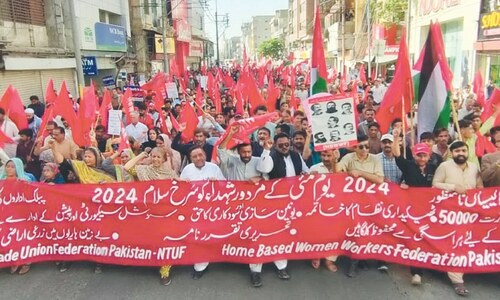OPERATION Zarb-i-Azb may have been an urgently needed military operation, but it was also obvious at the time of its launch that it would be the apogee of counter-insurgency operations in Fata.
Once Zarb-i-Azb would be completed, militarily the clear-and-hold phases across all seven agencies would have little further to go. Now, the country appears to be at a stage where the military is turning its attention to what comes after clear and hold — in fashionable counter-insurgency parlance, that should be the build-and-transfer stages.
Adjusting for local realities that would mean the mass resettlement of IDPs, Fata reforms and the rehabilitation of a civilian administrative apparatus that can focus on socioeconomic needs to bolster the security that the military has provided.
Yet, as Zarb-i-Azb comes to an operational close — with the capture of major heights and strategic passes in North Waziristan, large-scale fighting will likely end in the region — there are several questions that need to be asked.
First though, the bravery and courage of the soldiers and military personnel who risked their lives for the country’s safety and security should be warmly applauded.
What, however, about the numbers of alleged militants killed in the final, Shawal phase of the operation so far?
The figure provided by the ISPR, 207 militants killed, is small for an area that has proved so difficult to capture.
Have many more militants done what they have done before in other regions ie melted away into adjoining areas? If so, where have they gone? And what is the military’s plan to progressively stamp out the last militant sanctuaries?
The morphing of Zarb-i-Azb from a counter-insurgency operation in Fata into a broader counter-terrorism agenda across the country ought also to be questioned.
The fight against militancy was always going to be a long one and there is a great deal of interconnectedness between militancy in Fata and terrorism in the rest of Pakistan, but specific operations do need closure.
The fate of North Waziristan should be clear and separate from the very different nature of counter-terrorism and intelligence-led operations that are continuing across the country.
Closure also provides a relatively straightforward way to assess military claims. Rah-i-Raast (Swat), Rah-i-Nijaat (South Waziristan), Operation Thunder (Mohmand Agency), Khyber-I and Khyber-II were each launched and eventually concluded, allowing the claims of military success to be tested against realities on the ground.
Similarly, Zarb-i-Azb and its conclusion would allow Fata and its residents to turn their attention fully to reconstruction, resettlement and political reforms.
For all the sacrifices made by the residents of Fata and the military, the gains are far from permanent.
Fata cannot simply return to its pre-insurgency way of life. Yet, meaningful reforms and socioeconomic uplift become all the more difficult in the face of an open-ended military operation, even if just in name.
Published in Dawn, March 16th, 2016










































